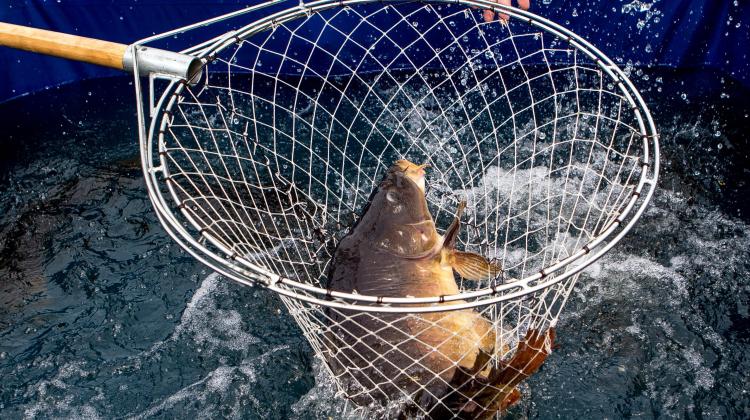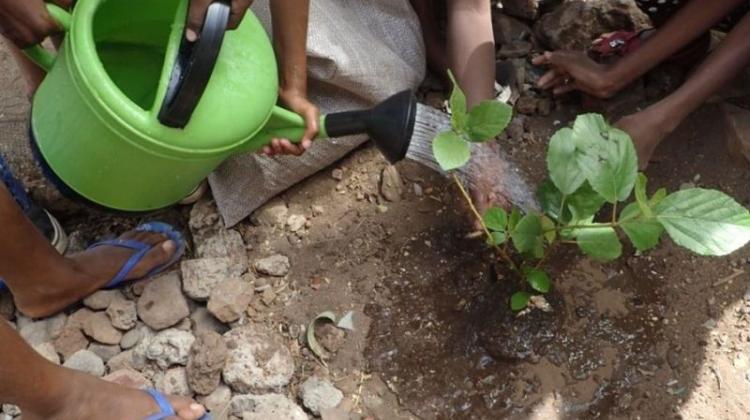Scientists developed a method for breeding the local fish - the ziege
 Photo by Roman Kujawa
Photo by Roman Kujawa
The method of controlled reproduction of the ziege - a fish living in the Vistula Lagoon, has been developed by scientists from Olsztyn. The ziege, thanks to large, horizontally positioned pectoral fins shaped like wings, can jump out of the water and "fly" in the air for several meters.
Biotechnology of the ziege breeding and rearing its larvae under controlled conditions, has been developed by head of the Department of Lake and River Fisheries at the University of Warmia and Mazury in Olsztyn - Prof. Roman Kujawa.
"The objective of the project was to acquire spawners, obtain sex products from them (eggs and sperm), incubate eggs and grow brood under controlled conditions at varying temperature, density, salinity and using different kinds of feed. As a result of years of research, we obtained the ziege fry in controlled conditions, which nobody has been able to do until now" - said Prof. Kujawa.
According to the scientist, the hardest part of the project was to acquire spawners from their natural environment. The ziege live in sea lagoons and rivers that supply them. It is a protected species in all waters except the Vistula Lagoon, where its population is still quite strong.
"Spawners are very sensitive to manipulation associated with catching. Commonly used methods of catching using gillnets or fyke nets are not neutral for them. Fyke nets, which are trap-type equipment would seem to be an optimal tool for catching the ziege spawners, but as it turned out, fish caught in them also suffered injuries. This is due to the specificity of the Vistula Lagoon, which is a shallow basin. Fyke nets are placed in shallow water and even the smallest waves expose the fish caught to abrasions caused by trap walls. Their body is damaged, it quickly loses scales and fish without scales dies" - said Prof. Kujawa.
He added that even when scientists manage to catch the ziege in the condition that guarantee its survival, they face difficulties in transporting the fish to the harbour, from where they are transported to the laboratory. The ziege is a fast and energetic fish, which in the moment of danger can strike the vessel wall with huge impetus, which may cause cracked mouth. It is also sensitive to hypoxia, so it has to be transported in a container equipped with devices that supply oxygen to water.
The ziege starts breeding when the water is approx. 16 degrees Celsius. In the natural environment, they head to the rivers to spawn, for example to Pasłęka, and after swimming a few hundred meters upstream they spawn. The ziege is the only freshwater fish in Europe that lays eggs that float freely in the water with the current. After spawning, adult fish swim back to the lagoon, and so do their eggs, but at a much slower speed. After hatching, the larvae quickly fill swim bladders with air and begin to swim in search of food.
An interesting fact is that the ziege eggs after swelling can reach the size of 4-5 mm in diameter, have a very large perivitelline space, so they are easily carried downstream.
Under controlled conditions and after hormonal stimulation Olsztyn scientists obtained eggs and sperm from the adult ziege caught in the lagoon. After the artificial spawning, egg incubation, larvae were also obtained and grown to 18 cm in length.
The ziege is an unusual species because it resembles flying fish. Its pectoral fins have the shape of wings and are arranged horizontally. Thanks to this feature, and high-speed swimming, when in danger the fish is able to jump above the water surface and fly from tens of centimetres to several meters above the water. "This behaviour makes it unlike any other fish in Poland, resembling tropical flying fish" - added the scientist.
The shape of the ziege body is also interesting, its silhouette is similar to a machete or pirate knife. One of the English names of the fish directly refers to its shape (sabrefish). Fishermen from the Vistula Lagoon commonly call the ziege "goat".
Due to the large number of bones, the ziege has no economic significance. In the past, it was caught in large amounts and eaten after salting or smoking. Its eggs were also a delicacy. Guanine crystals obtained from its scales were used in the manufacture of artificial pearls. "Fishermen from the lagoon say that the ziege +has no bones only in the eyes+, but apparently it is very tasty, if you grind the meat three times" - said Prof. Kujawa.
The researchers emphasize that despite small economic value, the ziege is an important species because its presence indicates biodiversity. A compendium of knowledge about the ziege can be found in the monograph "The ziege" prepared to conclude the project and published by the University of Warmia and Mazury Publishing House in Olsztyn.
PAP - Science and Scholarship in Poland, Agnieszka Libudzka
ali/ agt/ mrt/
tr. RL
Przed dodaniem komentarza prosimy o zapoznanie z Regulaminem forum serwisu Nauka w Polsce.

















